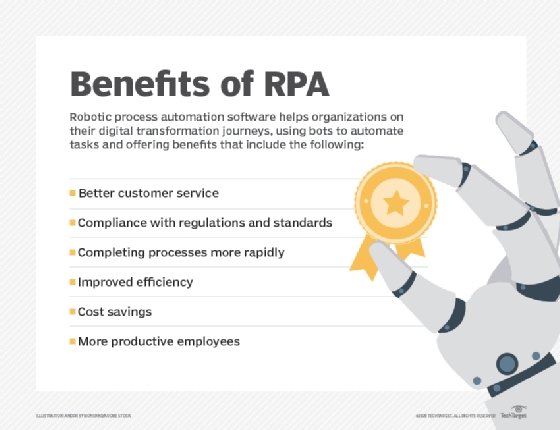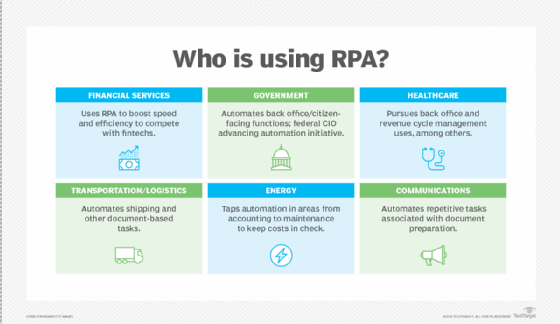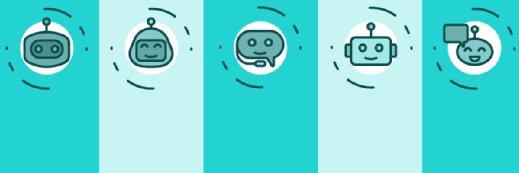Attended vs. unattended RPA bots: Key differences
RPA software can be triggered manually or automatically. Learn the differences between unattended and attended RPA bots and how both can boost productivity and efficiency.
Executives are turning to automation to increase efficiencies, reduce human errors, improve customer experience and cut costs, with many of them opting for robotic process automation software as the tool of choice.
RPA is a technology designed to mimic how humans interact with the software applications they use to complete repetitive, often large volume, tasks.
Organizations are programming RPA "bots" to perform tasks within their business processes. This digital workforce of bots is intended to either free up human workers to handle more complex tasks by removing mundane repetitive tasks from their list of responsibilities or assist human workers as they go about their jobs.
The RPA bots can be divided into two main modes -- unattended or attended -- depending on how they operate within the enterprise. Some vendors label the two types as unassisted and assisted bots.
This article is part of
Ultimate guide to RPA (robotic process automation)
Here's a look at what differentiates the two main categories of RPA bots, with a section at the end on hybrid bots, or AI-assisted RPA.
Unattended RPA bots
 Carl Lehmann
Carl Lehmann
Unattended bots execute tasks without any human involvement, having been programmed to interact directly with computer systems to run through a business process or task from start to finish. These RPA bots know to start their work based on an established scheduled or when a certain event occurs that triggers the automated process to begin. They run in the background and once they are finished with their tasks, they pass off their products to a human worker or another machine.
"The vast majority of software bots crafted today by RPA have been designed to run unattended," said Carl Lehmann, principal analyst for architecture, automation and integration at 451 Research, within S&P Global Market Intelligence.

Examples of unattended RPA
Unattended RPA bots handle manual tasks that follow a specific pattern or specific set of steps that are meant to be followed the exact same way each time the task is performed. There are no variations in how the task is meant to be performed.
RPA came along to automate those tasks so they can be executed in high-volume batch mode. For example, if a bank wants to increase the ATM withdrawal limits for its customers in advance of an event such as an ongoing hurricane, RPA bots can more quickly and efficiently reset the limits in every single customer account compared to a human worker.
"Unattended bots make sense for fundamental repetitive tasks that need to be executed at scale in large quantities," Lehmann said.
 Justin Richie
Justin Richie
A common unattended bot works in contact centers, offering to take a customer's phone number to put in queue for a call back from a human worker that can handle the customer's request. Another example is an RPA platform that takes data from one place and automatically populates that information in other computer systems where it's needed.
Such cases illustrate the benefits of these RPA bots, said Justin Richie, vice president of data and AI at Nerdery. They not only free human workers from having to perform mundane manual tasks, thereby saving time and money, but also work faster and without error.
Attended RPA bots
Attended bots, on the other hand, are programmed to work alongside humans. They handle certain tasks within longer, more complex workloads or processes that cannot be fully automated from start to finish. The attended bots are used for virtual assistance, guidance and on-demand data processing.
 Gina Schaefer
Gina Schaefer
"Attended automation is meant to interact with a human," said Gina Schaefer, managing director and intelligent automation lead at Deloitte Consulting LLP. She explained that the places where humans are doing the work are usually the tasks in the bot-assisted processes where the rules are so complex or don't follow any specific pattern that they can only be performed by humans.
A contact center professional, for example, could trigger an attended RPA bot as soon as they answer a customer call, with the bot retrieving information about that customer from various applications and then putting that information in front of the worker. This lets the worker best serve the customer as quickly as possible by not having to spend time manually retrieving computer files for data required.
There are attended bots designed to handle tasks before connecting with a human at a certain point in the process that will then take over and move the process forward. "The RPA vendors are trying to position these attended bots as a digital workforce, to perform tasks to augment human workers so they can be more productive and multifaceted, meaning those attended bots codify skills that the human may not have," Lehmann explained.
An accounts payable clerk required to perform several accounts receivable tasks could be aided by an attended RPA bot to help with that part of their job. A procurement professional could launch a bot to compare a purchase order, an invoice and an advanced shipping notice.
"That comparison is a tedious task, so a software bot would help them be more productive," Lehmann said. "That's how an attended bot can codify unique skills -- in this case, comparing documents -- that a worker might not otherwise know how to do."
Attended RPA bots also work to support human decision-making. A customer service representative, for instance, could launch a bot that analyzes customer information and then use the analysis to suggest the best products for the service rep to offer to the customer.

Hybrid RPA bots
Hybrid bots bring AI into the mix, Lehmann said. "It's AI augmented attended bots."
For example, a hybrid RPA bot using natural language processing could listen to a conversation between two people, analyze that conversation in real time and then use that analysis to provide information that will help the attending human take the necessary next steps. Or the AI-assisted bot could be interacting with a person, and when certain needs arise in that conversation that call out to a human worker, they will join the process to add further value to the interaction.
Hybrid RPA bots are used most often in customer-facing scenarios, where they help workers best handle customer needs during their interactions.
Mary K. Pratt is an award-winning freelance journalist with a focus on covering enterprise IT and cybersecurity management.








